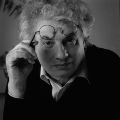Fulvio Irace

Biographical notes
Fulvio Irace is a full professor of “History of Architecture” at Milan Polytechnic, where he holds the History of Contemporary Architecture chair at the Faculty of Civil Architecture and the Faculty of Design; he is also a visiting professor at the Academy of Architecture in Mendrisio, and a member of the board of teachers for the PhD course in “History of Architecture and Town Planning” at Turin Polytechnic.
He is a member of the scientific committee of the Vico Magistretti Foundation and is on the board of trustees of the Piano Foundation.
In 2008-2009 he was a member of the jury for the Mies van der Rohe European Prize.
From 2005 to 2009 he was a member of the Scientific Committee of the Milan Triennial and curator of the Architecture and Territory sector.
One of the founders of the national association AAI (Archivi di Architettura Italia – Italian Architectural Archives), he is one of the promoters of the “Architecture and Design” section of CASVA (Centro alti studi e valorizzazione delle arti – the Centre for Higher Studies and Valorisation of the Arts) of the Municipality of Milan.
Architectural editor for the publications “Domus” and “Abitare”, he has worked with the most important national and international magazines in the sector, and in 2005 was awarded the Inarch Bruno Zevi Prize for architectural criticism. Since 1986 he has been an opinionist in the field of architecture for the Sunday Supplement of “Il Sole 24 Ore”.
Attentive to the historiographies of Italian architecture between the two World Wars, to which he has dedicated much work through various exhibitions and publications, more recently his studies have concentrated on contemporary Italian architecture, and the figure of Renzo Piano, the subject of various monographs and an important exhibition at the Milan Triennial.
In the field of criticism and historical methodology he is the author of the following works: Dimenticare Vitruvio, 2001 and 2008; Le città visibili: Renzo Piano 2006; Divina Proporzione, 2007; Gio Ponti, 2009.
He has curated a number of architectural exhibitions.
Fulvio Irace is a full professor of “History of Architecture” at Milan Polytechnic, where he holds the History of Contemporary Architecture chair at the Faculty of Civil Architecture and the Faculty of Design; he is also a visiting professor at the Academy of Architecture in Mendrisio, and a member of the board of teachers for the PhD course in “History of Architecture and Town Planning” at Turin Polytechnic.
He is a member of the scientific committee of the Vico Magistretti Foundation and is on the board of trustees of the Piano Foundation.
In 2008-2009 he was a member of the jury for the Mies van der Rohe European Prize.
From 2005 to 2009 he was a member of the Scientific Committee of the Milan Triennial and curator of the Architecture and Territory sector.
One of the founders of the national association AAI (Archivi di Architettura Italia – Italian Architectural Archives), he is one of the promoters of the “Architecture and Design” section of CASVA (Centro alti studi e valorizzazione delle arti – the Centre for Higher Studies and Valorisation of the Arts) of the Municipality of Milan.
Architectural editor for the publications “Domus” and “Abitare”, he has worked with the most important national and international magazines in the sector, and in 2005 was awarded the Inarch Bruno Zevi Prize for architectural criticism. Since 1986 he has been an opinionist in the field of architecture for the Sunday Supplement of “Il Sole 24 Ore”.
Attentive to the historiographies of Italian architecture between the two World Wars, to which he has dedicated much work through various exhibitions and publications, more recently his studies have concentrated on contemporary Italian architecture, and the figure of Renzo Piano, the subject of various monographs and an important exhibition at the Milan Triennial.
In the field of criticism and historical methodology he is the author of the following works: Dimenticare Vitruvio, 2001 and 2008; Le città visibili: Renzo Piano 2006; Divina Proporzione, 2007; Gio Ponti, 2009.
He has curated a number of architectural exhibitions.
close





